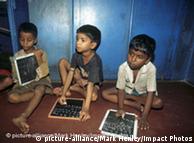 |
| Primary Education in India is the Country's Problem Child | ||
 | Many primary school children in India don't have proper teachers to train them | ||
| Sixty-two years after India’s independence, many of India's children are still not getting schooling. Although a constitutional directive urges all states to provide free and compulsory education for all children up to the age of 14, India is still far from achieving it. More than 80 percent of India's children start school in the first grade, but less than 50 percent continue up to grade eight -- which means that dropout rates are high. That's what the latest official statistics say. The government of India started a Sarva Shiksha or "Education for all" plan in 2001 and pledged that by 2005 it would get every Indian child into school. Disparity between enrolment and attendance While this has lead to more than 90 percent enrolment rates in some places, many non-governmental reports have found that many students are just registered while on average only 70 percent of them attend classes. Aditya Natraj, Programme Director of the Gujarat state operations of Pratham, India’s largest educational NGO, explains the disparity between enrolment and attendance: "Some children are enrolled there because teachers are pressured to enrol a large number of children in order to keep their jobs. But actually those children are studying in a local private school or dropped out from the school but you still keep them on the rolls. The other reason can be that schools are designed as per the urban lifestyle so the rural schools do not have any break for the harvesting season when children go to work to bring in the harvest. The third reason is that unfortunately in several schools teacher attendance is itself very weak." Sugandha, a so-called Gandhi fellow, is attached to an organisation which works with the government to improve education in rural India, and is based in a village in Rajasthan in Northern India. "Teachers are there in the school but they do not go to the classes to teach", she says. "They see it as a burden to teach the students." Many students are attracted to school to get a free lunch offered there by the government. But even then, Sugandha says, the quality of education provided in the rural schools is a problem: "Many times, even a standard 7 student does not know how to read and write. They do not know ‘A, B, C, D’. They are not able to form sentences." Lagging behind China India's failure in primary education becomes more apparent when compared to its neighbour China which has long attained almost full literacy. Aditya Natraj explains why India is lagging behind: "India spends three and a half percent of its GDP on education while China spends six percent on education and until we make that provisioning we are not going to catch up with China. So it's basically financial provisioning. Apart from that there are a lot of technical issues. In order to educate such a large number of children you need a lot of capacity development of a large number of teachers, improving the quality of schools." Experts agree that a dramatic change is needed to improve the education system of India from grassroots level, including stricter checks on the functioning of schools and the quality of teaching. Otherwise, many bright minds will continue to lack a proper education in India, which is more and more relying on knowledge-based industries to compete on world markets. Author: Debarati Mukherjee |